
The gaming industry stands at the precipice of a revolutionary transformation, where artificial intelligence meets blockchain technology to democratize game creation.
This comprehensive guide explores Redbrick and its native BRIC token, providing insights into how this AI-powered gaming engine is reshaping Web3 gaming through innovative creator economies, seamless multi-chain integration, and accessible game development tools. Whether you’re a developer, gamer, or crypto investor, understanding Redbrick’s unique approach to solving Web3 gaming’s fundamental challenges offers valuable perspective on the future of interactive entertainment and digital asset monetization.
Key Takeaways
- Redbrick is a next-generation AI-powered gaming engine that democratizes game creation through text-to-game functionality, enabling anyone to build games without coding knowledge
- BRIC token serves as the native utility token powering creator monetization, player rewards, and platform operations within the Redbrick ecosystem
- The platform has achieved impressive traction with over 7.6 million signups, 5.9 million wallets, 53 million games played, and 78 million on-chain transactions
- AI-driven tools including Visual Coding Engine and multi-chain compatibility solve key Web3 gaming challenges like complexity barriers and blockchain fragmentation
- Dual-currency system combines off-chain points for engagement rewards with on-chain BRIC tokens for monetization, creating sustainable creator economy incentives
- Strategic roadmap progresses through three phases, with BRIC token launch scheduled for Phase 2 alongside full token economy implementation
- Competitive advantages include unique AI accessibility, comprehensive creator monetization, and seamless Web2-Web3 bridging compared to traditional gaming platforms
Table of Contents
What is Redbrick (BRIC Token)?
Redbrick is a next-generation AI-powered gaming engine that makes game creation faster, easier, and more accessible to everyone, regardless of technical skill level. By leveraging cutting-edge AI-driven tools, Redbrick removes traditional barriers in game development, enabling anyone to effortlessly create, customize, and monetize casual games while bridging Web2 and Web3 ecosystems.
BRIC is the native utility token powering the entire Redbrick ecosystem, designed to facilitate value creation, exchange, and participation across a community-driven gaming economy. The token serves as the backbone for creator monetization, player rewards, platform operations, and ecosystem governance, creating sustainable economic incentives that align all stakeholders within the platform.
With impressive metrics including over 7.6 million signups, 5.9 million wallets, and 53 million games played supported by 78 million on-chain transactions, Redbrick has established itself as a leading force in AI-driven game development. The platform consistently engages 64,000+ daily active users and 170,000+ monthly active users, showcasing robust community participation across its growing ecosystem.
Redbrick vs BRIC Token: Key Differences
| Aspect | Redbrick | BRIC Token |
|---|---|---|
| Definition | AI-powered gaming engine and platform | Native utility cryptocurrency |
| Function | Enables game creation, publishing, and monetization | Facilitates payments, rewards, and governance |
| Scope | Complete ecosystem with tools and services | Digital asset for value exchange |
| Usage | Creating games, accessing features, community building | Paying fees, earning rewards, staking, trading |
| Target Users | Creators, players, partners, developers | Token holders, ecosystem participants |
| Technology | AI Engine, multi-chain support, content service layer | Blockchain-based utility token with staking |
What Problems Does BRIC Crypto Solve?
1. Game Creation Complexity and Time Barriers
Traditional game development requires weeks or months just to build basic prototypes, demanding extensive coding knowledge and complex tool mastery. Developers must constantly switch between design, testing, and debugging phases, limiting creativity and making it nearly impossible for small teams or solo creators to compete effectively in fast-moving markets.
2. Blockchain Fragmentation and Overwhelm
The proliferation of numerous blockchains creates confusion for game creators who struggle to choose the right platform. Each blockchain offers different ecosystems, tools, and user bases, making decision-making overwhelming and slowing innovation while discouraging creators from entering Web3 gaming.
3. Community Fragmentation Across Platforms
Web3 gaming communities remain scattered across different platforms, chains, and ecosystems, preventing the formation of unified, engaged audiences. This fragmentation makes it harder for creators to grow sustainable player bases, market their games effectively, and build reliable revenue streams.
4. Poor Balance Between Fun and Functionality
Many existing Web3 games prioritize financial incentives over engaging gameplay, making experiences feel more like work than entertainment. Others become overly complex, requiring deep blockchain knowledge just to participate, which severely limits mainstream adoption and prevents Web3 gaming from reaching broader audiences.

The Story Behind BRIC Coin and Redbrick Platform
Redbrick emerged from a vision to transform the fragmented and overly complex Web3 gaming landscape into an accessible, AI-driven ecosystem where anyone can create and monetize games. The platform was built on the belief that Web3 gaming was fundamentally broken due to high technical barriers, poor gameplay experiences, and ecosystem fragmentation that hindered both creators and players.
From its inception, Redbrick focused on building a solid foundation while achieving key milestones that demonstrate real value creation for creators, users, and partners. The platform has successfully powered over 100 games while gathering a highly active community spanning both Web2 and Web3 ecosystems, proving that accessible game creation tools can drive meaningful engagement and adoption.
The project’s rapid growth to over 7.6 million signups, 5.9 million wallets, and a thriving community of 368,000+ Discord members and 500,000+ Twitter followers showcases the demand for simplified, AI-powered game development solutions that bridge traditional and blockchain gaming experiences.

Key Features of Redbrick Platform
1. AI-Powered Game Creation Engine
Redbrick’s proprietary AI Engine combines multiple development tools including text-to-game functionality, 2D/3D engines, and visual coding systems. The AI Game Engine enables full game and asset creation from simple prompts, allowing developers to generate characters, environments, and mechanics effortlessly without extensive technical knowledge.
2. Visual Coding and No-Code Development
The platform features a patented Visual Coding Engine that provides a no-code interface, enabling non-programmers to design and develop Web3 applications using intuitive visual elements. This innovation significantly lowers entry barriers and invites more creators into the Web3 space while maintaining professional-quality output.
3. Multi-Chain Compatibility and Account Abstraction
Redbrick supports major Layer 1 blockchains including Ethereum, BNB, Monad, and Polygon, alongside leading Layer 2 solutions. The implementation of account abstraction allows users to create wallets and manage transactions more intuitively, making blockchain-based games feel closer to traditional gaming experiences while reducing technical friction.
4. Comprehensive Creator Economy Infrastructure
The platform implements a dual-currency system combining off-chain points for engagement rewards and on-chain BRIC tokens for monetization. Creators can earn through game engagement, ad revenue sharing, asset sales, and milestone achievements, while maintaining full control over their content and intellectual property.
5. Cross-Platform Integration and Accessibility
Redbrick offers seamless distribution across all major devices and operating systems while integrating naturally with Web3 ecosystems. The platform connects with popular platforms like Telegram and Discord, enabling creators to reach massive audiences through features like play-to-airdrop and tap-to-earn mini-games.
Redbrick Real-World Use Cases
1. AI-Powered Casual Game Development
Creators leverage Redbrick’s text-to-game functionality to rapidly prototype and deploy casual games without coding knowledge. The platform has already powered over 100 games, demonstrating practical application in streamlining game development from concept to publication within hours rather than weeks.
2. Creator Monetization and Asset Trading
Game developers utilize the platform’s integrated marketplace to design and sell assets including characters, environments, animations, and in-game items. The dual-currency system enables creators to earn both engagement-based points and blockchain-based BRIC tokens through various monetization streams.
3. Play-to-Earn Gaming Experiences
Players participate in daily missions, tournaments, and seasonal events to earn rewards while enjoying games created by both the Redbrick team and community creators. The platform’s BRC:ID token standard allows users to package off-chain progress and achievements into verifiable on-chain assets tradeable as NFTs.
4. Web3 Integration for Traditional Projects
Partners use Redbrick’s cross-platform compatibility to build games directly through the AI engine or collaborate with the global creator network. Blockchain foundations, gaming projects, and NFT collections develop custom gaming experiences that increase engagement and strengthen communities while improving long-term user retention.
5. Community-Driven Content Creation
The platform supports a creator community of over 200,000 creators with more than 600,000 content pieces created, showcasing the ecosystem’s capacity for user-generated entertainment and demonstrating scalable content production through AI-assisted tools.

Tokenomics of Redbrick
As of the current development phase, detailed tokenomics information for BRIC token has not yet been officially released by the Redbrick team. The project is currently in the transition period between Phase 1 (completed) and Phase 2 of their roadmap, where “BRIC Token Launch” is scheduled to occur alongside the full implementation of the token economy.
The Redbrick team has prioritized establishing a solid platform foundation and proving product-market fit before releasing comprehensive tokenomics details. This approach ensures that the token economics are carefully designed based on real usage data and community feedback from the platform’s substantial user base of over 7.6 million signups.
Investors and community members can expect tokenomics information including total supply, distribution schedules, and allocation breakdowns to be announced closer to the official BRIC token launch. For the latest updates on tokenomics release, users should follow Redbrick’s official social media channels and announcements.

BRIC Token Functions and Utility
1. Creator Economy Empowerment
BRIC serves as the primary monetization vehicle for game creators, who earn tokens when users play their games based on engagement metrics. Creators receive shares of advertising revenue from their content and can sell in-game items, characters, and digital assets directly to players through integrated marketplaces, while unlocking bonus rewards by reaching growth milestones.
2. Player Reward and Engagement System
Players earn off-chain points through daily gameplay that convert into BRIC tokens, creating sustainable play-to-earn mechanics. The platform offers quests, missions, and seasonal events where participants can win tokens and limited-edition rewards, with consistent play increasing point yield and conversion opportunities.
3. Platform Operations and Service Fees
BRIC functions as the core currency for all platform services through account abstraction implementation. Users pay platform fees including game publishing, NFT minting, in-game purchases, tournament participation, and access to premium features directly in BRIC, reinforcing its role as the central utility token.
4. Staking Benefits and Exclusive Access
Token holders can stake BRIC to earn periodic rewards while unlocking exclusive tournaments and gameplay advantages. Staking provides access to premium creator features, visibility boosts, and early access to newly launched games, giving stakers head starts in earning rewards and collecting assets before wider community participation.
5. Ecosystem Value Circulation
BRIC powers the entire platform economy through asset trading, marketplace transactions, and creator tool access. Every interaction from content creation to consumption ties back to BRIC circulation, creating a self-sustaining token economy that aligns incentives across creators, players, and platform operations.

The Future of BRIC Crypto and Redbrick
Redbrick’s development follows a strategic three-phase roadmap designed to progressively expand platform capabilities while strengthening token utility and ecosystem participation. The platform has successfully completed Phase 1 milestones including Playstore launch, reward systems, AI assistant integration, gaming tournaments, and creator economy pilot programs.
Phase 2 focuses on full BRIC token economy implementation, featuring token conversion systems, creator economy launch, staking mechanisms, and on-chain asset integration. This phase establishes the foundation for sustainable tokenized value exchange while maintaining the platform’s core gaming focus.
Phase 3 envisions comprehensive ecosystem maturation through publishing automation, marketplace expansion, AI-powered asset generation, and advanced interoperability features. The platform aims to become a unified bridge between Web2 and Web3 gaming, enabling seamless cross-platform experiences while maintaining accessibility for creators of all skill levels.
The long-term vision positions Redbrick as an inclusive platform where users and creators can easily monetize talents by transforming content and gameplay into real economic value. By leveraging AI-driven creation tools and blockchain-powered monetization, the platform seeks to make Web3 content accessible to mainstream audiences while fostering collaboration between traditional and decentralized gaming ecosystems.

BRIC Token Competitors Analysis
Redbrick operates in the intersection of AI-powered game development and Web3 creator economies, facing competition from several categories of projects including traditional game development platforms, Web3 gaming infrastructure, and creator economy tokens.
- Traditional game development competitors like Unity, Unreal Engine, and Roblox offer sophisticated creation tools but lack integrated blockchain monetization and AI-driven accessibility features. While these platforms have established market presence, they require significant technical expertise and don’t provide native cryptocurrency rewards or NFT integration.
- Web3 gaming infrastructure projects such as Immutable X, Gala Games, and The Sandbox focus on blockchain gaming but typically don’t offer the AI-powered creation simplicity that Redbrick provides. These platforms often require extensive development knowledge and don’t emphasize the text-to-game functionality that democratizes game creation.
- Creator economy tokens like Chiliz (CHZ) and Flow (FLOW) enable content monetization but lack the specialized AI gaming engine that sets Redbrick apart. While they provide creator rewards, they don’t offer the comprehensive game development toolkit that enables non-technical users to build complete gaming experiences.
- Redbrick’s competitive advantages include its unique combination of AI-driven accessibility, comprehensive creator monetization, and seamless Web2-Web3 bridging. The platform’s proven track record with over 7.6 million signups and 53 million games played demonstrates real market traction, while its dual-currency system and multi-chain compatibility provide flexibility that specialized platforms often lack.
Where to Buy BRIC Token
BRIC token is available for trading on MEXC, a leading cryptocurrency exchange known for its comprehensive security measures and user-friendly interface. MEXC provides a reliable platform for purchasing BRIC tokens with competitive trading fees and strong liquidity support, making it an ideal choice for both new and experienced crypto traders.
The exchange offers robust security protocols to protect user assets while maintaining 24/7 customer support for assistance with any trading-related questions. MEXC’s reputation for listing innovative gaming and creator economy tokens makes it a natural fit for BRIC token trading, providing traders with access to this AI-powered gaming ecosystem through a trusted platform.
How To Buy BRIC Token
Step-by-Step Purchase Guide on MEXC:
- Create a MEXC account by visiting the official website and completing registration.
- Complete KYC verification to meet security and regulatory requirements.
- Deposit funds into your MEXC wallet using supported cryptocurrencies like USDT.
- Navigate to the trading section and search for the BRIC trading pair.
- Select the BRIC/USDT pair from the available trading options.
- Choose your order type between market order (immediate purchase) or limit order (set price).
- Enter the amount of BRIC tokens you wish to purchase.
- Review and confirm your transaction details before submission.
- Execute the trade and receive your BRIC tokens in your MEXC wallet.
- Consider withdrawing your tokens to a personal wallet for enhanced security.
Conclusion
Redbrick represents a groundbreaking fusion of artificial intelligence and blockchain technology that addresses fundamental challenges in Web3 gaming through accessible game creation tools and sustainable creator economies. With its proven track record of over 7.6 million signups, comprehensive AI-driven development suite, and innovative dual-currency reward system, the platform demonstrates how technological innovation can democratize game development while creating meaningful economic opportunities.
The BRIC token serves as the cornerstone of this ecosystem, enabling seamless value exchange between creators, players, and platform operations through staking rewards, monetization mechanisms, and governance participation. As Redbrick continues executing its strategic roadmap toward full ecosystem maturation, the platform is positioned to become a leading bridge between traditional gaming and Web3 innovation.
For gaming enthusiasts, developers seeking accessible creation tools, and investors interested in the convergence of AI and blockchain technology, Redbrick offers a compelling opportunity to participate in the next evolution of interactive entertainment and digital asset monetization.
Maximize Your Crypto Journey with MEXC’s Referral Program
Looking to enhance your crypto trading experience? MEXC’s Referral Program offers an impressive 40% commission when you invite friends to join the platform. Simply share your referral code or link, and automatically earn commissions on your friends’ trading activities across both spot and futures markets. With daily commission distribution and rewards valid for up to 1,095 days from signup, MEXC’s referral program provides a sustainable way to grow your crypto portfolio while introducing others to one of the most comprehensive trading platforms for gaming and creator economy tokens like BRIC.
BRIC token airdrop now live! Exclusive MEXC campaign brings AI-powered gaming revolution to your portfolio!
Excited about Redbrick’s groundbreaking AI gaming engine and creator economy? MEXC now hosts an exclusive BRIC token airdrop campaign with generous rewards! Complete simple tasks to participate in this revolutionary platform that’s democratizing game creation through artificial intelligence. With over 7.6 million signups and 53 million games played, Redbrick is reshaping how creators build, monetize, and scale gaming experiences across Web2 and Web3 ecosystems. Don’t miss this opportunity to become an early adopter of the future where anyone can create games effortlessly—visit MEXC’s Airdrop+ page now and join the AI-powered gaming revolution!
Join MEXC and Get up to $10,000 Bonus!
Sign Up


